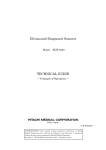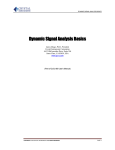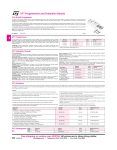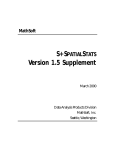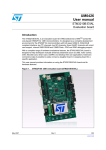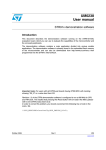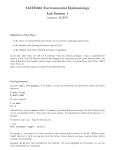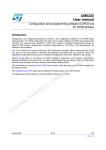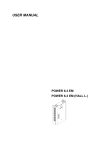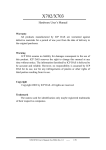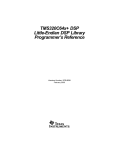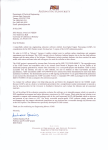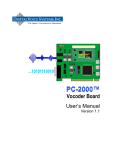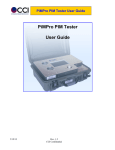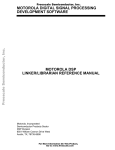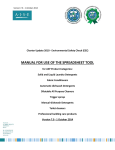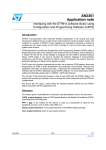Download STR91x DSP library (DSPLIB)
Transcript
UM0304
User manual
STR91x DSP library (DSPLIB)
Introduction
This manual presents a library of ARM assembly source code modules for digital signal
processing (DSP) applications such as infinite impulse response (IIR) filter, finite impulse
response (FIR) filter and fast Fourier transform (FFT) applicable for a range of DSP
applications including VSLP vocoder. These assembly source code modules are presented
for ARM mode and have been tested in an ARM9E-based STR91x platform.
In addition, the assembly source code modules have been tested in an IAR Workbench
environment as well, but STMicroelectronics cannot guarantee that these assembly source
code modules will be flawless for all applications.
The algorithm modules are presented "as is with no warranty".
June 2008
Rev 3
1/19
www.st.com
Contents
UM0304
Contents
1
2
3
4
2/19
Definitions and related documents . . . . . . . . . . . . . . . . . . . . . . . . . . . . . 4
1.1
Acronyms and terminology . . . . . . . . . . . . . . . . . . . . . . . . . . . . . . . . . . . . . 4
1.2
ARM and Thumb . . . . . . . . . . . . . . . . . . . . . . . . . . . . . . . . . . . . . . . . . . . . 4
1.3
References . . . . . . . . . . . . . . . . . . . . . . . . . . . . . . . . . . . . . . . . . . . . . . . . . 5
IIR ARMA 16-bit filter . . . . . . . . . . . . . . . . . . . . . . . . . . . . . . . . . . . . . . . . . 6
2.1
Description . . . . . . . . . . . . . . . . . . . . . . . . . . . . . . . . . . . . . . . . . . . . . . . . . 6
2.2
Function . . . . . . . . . . . . . . . . . . . . . . . . . . . . . . . . . . . . . . . . . . . . . . . . . . . 6
2.3
Arguments and variables . . . . . . . . . . . . . . . . . . . . . . . . . . . . . . . . . . . . . . 6
2.3.1
Calling the function from C . . . . . . . . . . . . . . . . . . . . . . . . . . . . . . . . . . . 6
2.3.2
Calling the function from assembly . . . . . . . . . . . . . . . . . . . . . . . . . . . . . 6
2.4
Algorithm . . . . . . . . . . . . . . . . . . . . . . . . . . . . . . . . . . . . . . . . . . . . . . . . . . 7
2.5
Assembly code . . . . . . . . . . . . . . . . . . . . . . . . . . . . . . . . . . . . . . . . . . . . . . 7
2.6
Requirements . . . . . . . . . . . . . . . . . . . . . . . . . . . . . . . . . . . . . . . . . . . . . . . 7
2.7
Implementation . . . . . . . . . . . . . . . . . . . . . . . . . . . . . . . . . . . . . . . . . . . . . . 8
2.8
Benchmarking . . . . . . . . . . . . . . . . . . . . . . . . . . . . . . . . . . . . . . . . . . . . . . 8
Block FIR 16-bit filter . . . . . . . . . . . . . . . . . . . . . . . . . . . . . . . . . . . . . . . . 9
3.1
Description . . . . . . . . . . . . . . . . . . . . . . . . . . . . . . . . . . . . . . . . . . . . . . . . . 9
3.2
Function . . . . . . . . . . . . . . . . . . . . . . . . . . . . . . . . . . . . . . . . . . . . . . . . . . . 9
3.3
Arguments and variables . . . . . . . . . . . . . . . . . . . . . . . . . . . . . . . . . . . . . . 9
3.3.1
Calling the function from C . . . . . . . . . . . . . . . . . . . . . . . . . . . . . . . . . . . 9
3.3.2
Calling the function from Assembly . . . . . . . . . . . . . . . . . . . . . . . . . . . . 10
3.4
Algorithm . . . . . . . . . . . . . . . . . . . . . . . . . . . . . . . . . . . . . . . . . . . . . . . . . 10
3.5
Assembly code . . . . . . . . . . . . . . . . . . . . . . . . . . . . . . . . . . . . . . . . . . . . . 10
3.6
Requirements . . . . . . . . . . . . . . . . . . . . . . . . . . . . . . . . . . . . . . . . . . . . . . 11
3.7
Implementation . . . . . . . . . . . . . . . . . . . . . . . . . . . . . . . . . . . . . . . . . . . . . 11
3.8
Benchmarking . . . . . . . . . . . . . . . . . . . . . . . . . . . . . . . . . . . . . . . . . . . . . 11
Complex 16-bit radix-4 FFT . . . . . . . . . . . . . . . . . . . . . . . . . . . . . . . . . . 12
4.1
Description . . . . . . . . . . . . . . . . . . . . . . . . . . . . . . . . . . . . . . . . . . . . . . . . 12
4.2
Algorithm . . . . . . . . . . . . . . . . . . . . . . . . . . . . . . . . . . . . . . . . . . . . . . . . . 12
UM0304
5
Contents
4.3
Arguments and variables . . . . . . . . . . . . . . . . . . . . . . . . . . . . . . . . . . . . . 14
4.4
Function . . . . . . . . . . . . . . . . . . . . . . . . . . . . . . . . . . . . . . . . . . . . . . . . . . 14
4.4.1
Calling the FFT function from C . . . . . . . . . . . . . . . . . . . . . . . . . . . . . . . 14
4.4.2
Calling the FFT function from assembly . . . . . . . . . . . . . . . . . . . . . . . . 15
4.5
The FFT function characteristics . . . . . . . . . . . . . . . . . . . . . . . . . . . . . . . 15
4.6
Performance benchmarking . . . . . . . . . . . . . . . . . . . . . . . . . . . . . . . . . . . 16
4.7
Fixed-point error benchmarking . . . . . . . . . . . . . . . . . . . . . . . . . . . . . . . . 17
Revision history . . . . . . . . . . . . . . . . . . . . . . . . . . . . . . . . . . . . . . . . . . . 18
3/19
Definitions and related documents
UM0304
1
Definitions and related documents
1.1
Acronyms and terminology
Table 1.
Definition of acronyms and terms
Term
ARM
ARMA
DSP
DSPLIB
ARM Core
Auto Regressive Moving Average
Digital Signal Processing
Digital Signal Processing Library
FIR
Finite Impulse Response
FFT
Fast Fourier Transform
IIR
Infinite Impulse Response
LTI
Linear Time-Invariant
MCU
1.2
Definition
Microcontroller Unit
STR91x
STR91x family of MCUs from STMicroelectronics
VSELP
Vector-Sum Excited Linear Prediction
ARM and Thumb
The Thumb set consists of 16-bit instructions that act as a compact, shorthand subset of the
32-bit ARM instructions. Every Thumb instruction could be executed via an equivalent 32bit ARM instruction. However, not all ARM instructions are available in the Thumb subset.
For example, there's no way to access status or coprocessor registers in Thumb. Also,
some functions that can be accomplished in a single ARM instruction can only be
accomplished with a sequence of Thumb instructions.
Thumb compatible processor can operate in ARM or Thumb state. Some method is needed
to switch the processor from executing instructions in one state to executing in the other.
This is provided by the Branch Exchange instruction, versions of which exist both in the
ARM and Thumb instruction sets. Both of these perform a branch by copying the contents
of general register Rn into the program counter causing a pipeline flush and refill from
address specified in Rn. Thus, BX is absolute rather than PC-relative.
In ARM state the format is:
BX{<cond>} Rn
In Thumb state the format is:
BX Rn
All ARM instructions are word-aligned, and all Thumb instructions are half-word aligned.
Therefore, the least significant bit in Rn can always be considered to be zero. The
4/19
UM0304
Definitions and related documents
processor can actually use this bit to determine if the instruction jumped to should be
executed in Thumb or ARM state:
●
If bit 0 set then execute in Thumb state
●
If bit 0 clear then execute in ARM state
Thumb was defined for two main reasons:
1.3
1.
Better code density, as the instructions are half the size of ARM instructions (although
some ARM instructions require two Thumb instructions for the same effect). You would
have to compile the application for ARM and Thumb and see what gives the best result.
2.
Better performance from narrow memory, as instruction fetches from smaller memory
(ie: 8-bit or 16-bit) will be reduced in Thumb mode.
References
1.
Sanjit K. Mitra, "Digital Signal Processing - A Computer Based Approach", McGraw
Hill, Third Edition 2006.
2.
R. Deka and J. G. Gardiner, "On the Fundamentals of Digital Signal Processing
Micros," Journal of Microcomputer Applications, Vol 17 No 1, pp 101-135, U K, January
1994.
3.
E. Oran Brigham, "The Fast Fourier Transform and its Applications", ISBN 0-13307547-8, Prentice-Hall International Editions, 1988.
4.
C.S. Burrus, "Unscrambling for fast DFT algorithms", IEEE Transactions on Acoustics,
Speech, and Signal Processing, ASSP-36(7), 1086-1089, July 1988.
5.
C. S. Burrus and T.W. Parks, "DFT/FFT and Convolution Algorithms - Theory and
Implementation", J. Wiley, 1985.
5/19
IIR ARMA 16-bit filter
2
IIR ARMA 16-bit filter
2.1
Description
UM0304
The IIR filter function performs an ARMA filter with 4 auto-regressive filter coefficients and 5
moving-average filter coefficients respectively for ny output samples. This is a 16-bit fixedpoint implementation. Reference [1] may be used to explore more about IIR filters.
2.2
Function
void iirarma_arm9e(void *y, void *x, short *h2, short *h1, int ny);
2.3
2.3.1
Arguments and variables
●
Output array vector y[ny+4] (used in actual computation. first four elements must have
the previous outputs. Thus the first output starts y[4] when ny = 0)
●
Input array vector x[ny+4]
●
Moving-average filter coefficients vector h2[5]
●
Auto-regressive filter coefficients h1[5] and h1[0] are not used
●
Number of output samples ny is a multiple of 4 and must be ≥ 8
Calling the function from C
Set the arguments and variables as appropriate in C main program and call the function.
In the STR91x DSPLIB this is set in the 91x_dsp.h header file.
2.3.2
Calling the function from assembly
Use the following registers equivalent to arguments/variables.
●
R0 to the address of output vector y[]
●
R1 to the address of input vector x[]
●
R2 to the address of coefficient vector h2[]
●
R3 to the address of coefficient vector h1[]
●
R12 to the address of ny
Then use the BL instruction to call the function.
6/19
UM0304
2.4
IIR ARMA 16-bit filter
Algorithm
Following is the C equivalent of the assembly code. Note that the assembly code is hand
optimized and restrictions may apply.
C equivalent IIR ARMA algorithm
iir_arma_arm9e(short *y, short *x, short *h2, short *h1, int ny)
{
int i, j;
int sum;
for (i=0; i<ny; i++){
sum = h2[0] * x[4+i];
for (j = 1; j <= 4; j++)
sum += h2[j]*x[4+i-j]-h1[j]*y[4+i-j];
y[4+i] = (sum >> 15);
}
}
2.5
Assembly code
The assembly code for this IIR ARMA algorithm is validated in STR91x environment for
ARM966E-S. The assembly code is for 16-bit fixed point applications. The assembly source
code module may be found in DSPLIB.
2.6
Requirements
The assembly module is little endian and written for ARM9E in ARM mode with stack
aligned to 8 bytes.
The module is for 16-bit fixed point applications where input data is expected to be 16-bit
fixed point and it will produce 16-bit fixed-point outpute.
A caller needs to organize an input vector x[] for filter input and output vector y[] for filter
output then supply the filter coefficients h1[] as well as h2[]. The vector length for x[] and y[]
needs to follow the following guidelines.
●
ny is multiple of 4 and greater than or equal to 8
●
Input data array x[ ] contains ny + 4 input samples to produce ny output samples.
7/19
IIR ARMA 16-bit filter
2.7
2.8
UM0304
Implementation
●
The output vector y[] contains ny + 4 locations, but its first 4 data are not used, i.e., first
output is y[4] while ny = 0.
●
The inner loop that iterated through the filter coefficients is completely unrolled.
●
The code is little ENDIAN.
●
The code is interrupt-tolerant but not interruptible.
Benchmarking
The benchmarking for this filter function is done using Chameleon Trace while the filter
function is running in STR91x engine with ARM966E-S. For the Chameleon Trace in ETM
Configuration Trace Port Size is set to 8 bit and Trace Port Mode is set to Normal, Half-rate
clocking, while the STR91x engine runs at 96 MHz.
Table 2.
8/19
Benchmarking of IIR ARMA algorithm module
Number of taps
Cycle count
Microseconds
72
6544
68.167
48
4396
45.792
24
2248
23.417
UM0304
Block FIR 16-bit filter
3
Block FIR 16-bit filter
3.1
Description
This function computes a direct-form real FIR filter using the coefficients stored in vector h[]
using a simple Block FIR technique, and moves delay line. The input sequence needs to be
start with (T -1) zeros. This is a 16-bit fixed-point implementation. Reference [1] may be
used to explore more about FIR filters.
The user needs to organize the output buffer for y[N] and needs to design the filter taps h[T]
and organize the coefficients in reverse order. The users also need to scale the input x[M]
and filter taps h[T] to avoid overflow.
This function may be called by C or Assembly function(s).
3.2
Function
typedef struct coef{
short *h;
unsigned int m;
}nh;
int fir_16by16_arm9e(int y[], short x[],
sx *p, int N);
nh p;
p.h = h;
p.M = T;
3.3
3.3.1
Arguments and variables
●
h[T] = filter coefficient vector with T number of taps, an integer multiple of 6
●
T = number of filter coefficients (taps), an integer multiple of 6
●
N = filter length or vector length for output
●
x[M] = filter input vector with total M samples, i.e., (M = N + T - 1)
●
y[N] = filter output vector with total N samples
Calling the function from C
Set the arguments and variables as appropriate in C main program and call the function.
9/19
Block FIR 16-bit filter
3.3.2
UM0304
Calling the function from Assembly
Use the following registers equivalent to arguments/variables.
●
Move N to R3, N is output filter length or output vector length, a multiple of 6
●
Move SP to R2, comparable &p as in C function above h[T] = filter coefficient vector
with T number of taps, T is an integer multiple of 6
●
Set R1 to the address of x, comparable as in x[M] filter input vector with total M
samples, i.e., (M = N + T - 1)
●
Set R0 to the address of y, comparable as in y[N] filter output vector with total N
samples
Then use BL instruction to call the function.
3.4
Algorithm
Following is the C equivalent of the assembly code. Note that the assembly code is hand
optimized and restrictions may apply.
Block FIR Filter Reference C Source
void fir_16by16_arm9e(short input, int nt, short h[], short z[])
{
int j;
short acc;
/* store input at the beginning of the delay line */
z[0] = input;
/* calc FIR */
acc = 0;
for (j = 0; j < nt; j++) {
acc += h[j] * z[j];
}
/* shift delay line */
for (j = nt - 2; j >= 0; j--) {
z[j + 1] = z[j];
}
return acc;
}
3.5
Assembly code
The assembly code for this block FIR 16-bit fixed-point filter algorithm is validated in STR91x
environment for ARM966E-S. The assembly code is for 16-bit fixed point applications, and
10/19
UM0304
Block FIR 16-bit filter
the filter coefficients are a multiple of 6 - more information is available in the source code.
The source code module may be found in DSPLIB.
3.6
Requirements
A caller needs to organize an input vectors say x[] and output vector say y[] for filter. The
caller needs to design the filter coefficients using any of the windowing functions such as
Hamming, Hanning, and Blackman etc as required by the filter response.
Then upon designing the coefficients, reverse the order of the coefficients. The number of
coefficients, T, must be an integer multiple of 6.
3.7
3.8
Implementation
●
The filter needs T number of coefficients and T is multiple of 6
●
The output vector y[N] is such that N equals (2 * T)
●
The input vector x[M] is such that M equals (N + T - 1)
●
The code is little ENDIAN
●
The code is interrupt-tolerant but not interruptible
Benchmarking
The benchmarking for this filter function is done using Chameleon Trace while the filter
function is running in STR91x engine with ARM966E-S. For the Chameleon Trace in ETM
Configuration Trace Port Size is set to 8 bit and Trace Port Mode is set to Normal, Half-rate
clocking, while the STR91x engine runs at 96 MHz.
Table 3.
Benchmarking of Block FIR algorithm module
Number of taps
Cycle count
Microseconds
72
15063
156.854
48
6842
71.271
24
1813
18.885
11/19
Complex 16-bit radix-4 FFT
4
Complex 16-bit radix-4 FFT
4.1
Description
UM0304
The DFT X[k] of a complex sequence x[n] of length N is calculated by:
X[k] = S n=0 N-1 x[n]*exp(-j2pnk/N) for k=0, 1,2 0.N-1
A direct calculation of N complex values of X[k] will require 4N2 multiplications and 4N(N-1)
additions given the trigonometric function values. For example, if N=128, 65536
multiplications and 65024 additions are required.
In this report, a radix-4 FFT algorithm is implemented. More details about FFT algorithms
including radix-4 are found in references [3] [4] and [5].
4.2
Algorithm
The algorithm works as follows:
Block 1: Bit reverse
Copy the data from the input buffer to the output buffer in bit-reversed order. It is an integer
between 0 and N-1, with binary representation as shown, for the bit reversal of k, we will
write. So we perform the equivalent of the following loop:
int k, khat, bit;
for (k=0, khat=0; k<N; k++) {
X[khat]=x[k];
for (bit=N/2; (khat & bit)!=0; bit >>=1) khat ^= bit;
khat ^= bit; /* finish incrementing khat */
}
The bit loop inside increments khat as a bit reversed number. If the input buffers and output
buffers are equal (X=x), more care needs to be taken to do the action in place, but it can be
performed faster as fewer elements need to be moved. Putting the elements in bit reversed
order has the effect of grouping together all the Ys and Zs of the previous subsection so no
further rearrangement needs to be done.
12/19
UM0304
Complex 16-bit radix-4 FFT
Block 2: Kernel
Perform the equivalent of the following loop:
●
denotes complex multiplication
# define pi 3.14159265358
for (n=2; n<=N; n <<= 1) {
w=2*pi/n;
for (m=0; m<N; m+=n) {
for (k=0; k<n/2; k++) {
y=X[m+k];
z=X[m+k+n/2] * exp(-ikw);
X[m+k]=(y+z)/2;
X[m+k+n/2]=(y-z)/2;
}
}
}
After n=2 we have performed N/2 two-element FFTs, positioned at offsets m=0, 2, 4, ... N-2.
After n=4 we have performed N/4 four-element FFTs positioned at offset m=0, 4, 8, … N-4.
After n=N we are left with the answer to the main FFT in the buffer X.
k bN 1 - ... b2
b1
b0
()?= 2
Because each pass of the FFT divides the data by 4 (radix4 passes) there is no bit growth.
Four cases were tested as shown in Table 4.
Table 4.
Bit growth of FFT routine
Case name
Description
Input amplitude
Output bin amplitude
Single sine max neg.
Single sine at 1600; Fs
=25600; 1 complete
waveform in 16
samples;
0x8001
2 bins of 0xC000 (+/0x2)
Single sine max pos.
Single sine at 1600; Fs
=25600; 1 complete
waveform in 16
samples;
0x7FFF
2 bins of 0x4000 (+/0x2)
13/19
Complex 16-bit radix-4 FFT
Table 4.
Bit growth of FFT routine
Case name
4.3
UM0304
Description
Input amplitude
Output bin amplitude
Dual sine max neg.
Two sines at 800, 1200;
0x8001
Fs =25600;
4 bins of 0xE000 (+/0x2)
Dual sine max pos.
Two sines at 800, 1200;
0x7FFF
Fs =25600;
4 bins of 0x2000 (+/0x2)
Arguments and variables
The algorithm takes three values on input:
4.4
●
A pointer x to the input data consisting of N complex numbers x[0], ...., x[N-1]. Each
complex number is a 32-bit integer containing the 16-bit real part followed by the 16-bit
imaginary part.
●
A pointer y to the output buffer for the transformed array to be stored. This buffer is the
same in size as the input buffer x, with same order as in input buffer for the real part as
well as the imaginary part.
●
An integer nBin giving the base 2 logarithm of the number of points N in the Fourier
Transform.
Function
extern void cr4fft1k16_arm9e(void *pssOUT, void *pssIN, int nBin);
The input to the function is an array of complex data with each even index the real part and
imaginary part being in odd index, e.g., x[0] real part and it imaginary part x[1]; x[2] real part
and it imaginary part x[3]; and so on … Similarly, the output is also in the same order.
The block outline of this FFT algorithm is shown in Table 5.
Table 5.
Block outline of FFT routine
Name
save_context
Implementation
Save all registers used by the
routine
d_main
Main loop; transfer 16 bytes per
single loop
iteration
d_swit
Second level switch: transfer 4,
8 or 12 bytes
linear routine
d_switch
Third level switch: transfer 1, 2
or 3 bytes
switch case
restore_context
4.4.1
Function
Restore all registers
Calling the FFT function from C
To call the FFT routine from C, include both 91x_dsp.c and 91x_dsp.h which declares the
type structure and the function FFT as:
extern void cr4fft1k16_arm9e(void *pssOUT, void *pssIN, int nBin);
14/19
UM0304
Complex 16-bit radix-4 FFT
Then to call the function from main use the following in main program as global:
struct complex_fft *test_fft = NULL;
and call the function using
test_fft->calc_cr4fft_1k(y, x, N);
The function can also be called directly using simple function call by main program. Note the
following points:
4.4.2
●
The buffers x and y may coincide. In this case the FFT is said to be done in place rather
than out of place.
●
To prevent overflow within the algorithm, the real and imaginary values in the array x
should be sign extended 16-bit quantities (between -32768 and +32767).
●
The values of N allowed are 64,256, 1024.
Calling the FFT function from assembly
To call the FFT routine from assembler, import the symbol FFT and set up the registers as
follows:
●
R0 to the address of the input buffer x
●
R1 to the address of the output buffer y
●
R2 to N
Call the FFT routine using BL FFT. On exit R0 will contain the exit code (0 if successful), R1R3 and R14 will have been corrupted and R4-R13 preserved.
4.5
The FFT function characteristics
Table 6.
The FFT function characteristics
Feature
Description
Name
Complex FFT
Algorithm choices
Radix4, DIT, Bit reverse in input, Not in place
Number of points
64 or 256 or 1024
Input data size
2 x 16-bit
Input data organization
imag_real (little endian)
such as real = address imag =address +2
Input data order
Linear (bit reverse is done during the first pass;
this is transparent to the user)
Computation radix
Radix 4 (Burrus Parks)
Overflow prevention
for every pass (radix 4) the data is right shifted
by 2 so that the resulting value does not
overflow;
Saturate on overflow
no
Rounding
none
Output data size
2 x 16-bit
Note
see normalized note
15/19
Complex 16-bit radix-4 FFT
Table 6.
UM0304
The FFT function characteristics
Feature
Description
Note
Output data
organization
imag_real (little endian)
such as real = address imag =address +2
Output data order
Linear
Coefficient size
16-bit
Coefficient organization
imag_real (little endian)
such as real = address imag =address +2
Coefficient computation
table lookup : sine table
method
Coefficient Table size
4080 bytes; = (1024 + 256 + 64+ 16 ) *4 *3/4
The STR91x implementation of the bit reversal stage is straightforward and contained
between the labels FFT and FFTSTART. The second stage begins at the label FFTSTART.
4.6
Performance benchmarking
We start by listing the performance for the speed optimized algorithm. Timings are given for
the STR91x running at 96 MHz. The code size for the optimized algorithm is 1592+ N/2
bytes (including the lookup-table) and the data size is 64 bytes (not including the input and
output buffers).
Table 7.
Benchmarking of Radix-4 Complex FFT Algorithm: STR91x 96 MHz.
Radix-4
complex FFT
64 Point
256 Point
1024 Point
Operation mode
Cycle count
Microseconds
Program in Flash & Data in SRAM
2701
28.135
Program & Data in SRAM
3432
35.750
Program & Data in Flash
3705
38.594
Program in Flash & Data in SRAM
13740
143.125
Program & Data in SRAM
18079
188.323
Program & Data in Flash
19908
207.375
Program in Flash & Data in SRAM
68534
713.896
Program & Data in SRAM
90422
941.896
Program & Data in Flash
101151
1053.656
All these results were obtained on a STR910-EVAL best case configuration for speed. The
clock is 96 MHz; the number of wait states is minimum for Flash and for SRAM. The code is
run from Flash.
16/19
UM0304
4.7
Complex 16-bit radix-4 FFT
Fixed-point error benchmarking
Table 8 shows fixed-point error analysis of FFT function (ARM966E-S) with respect to
floating-point and fixed-point C function, and amplitude, for a 16-point FFT.
Table 8.
The FFT function fixed-point error benchmarking
Real Part
Imaginary Part
Amplitude
ARM966E-S
Floating point Fixed-point C
ARM966E-S
Floating point Fixed-point C
-5552
-5549.4375
-5550
-5552
-5549.4375
-5550
7848.089844
21318
21320.33984
21319
-5841
-5840.29541
-5840
22105.78906
6297
6299.319336
6298
-1503
-1501.481567
-1502
6475.791016
4100
4101.071289
4100
-402
-401.039703
-401
4120.633301
3146
3146.563477
3146
208
208.557663
208
3153.467529
2573
2574.675781
2574
632
631.753662
631
2651.050293
2165
2166.108887
2165
967
967.559753
967
2372.382568
1836
1836.466064
1836
1262
1262.519897
1262
2228.578857
1543
1544.313599
1544
1543
1544.311401
1544
2183.987549
1261
1262.530396
1262
1836
1836.464233
1836
2228.583496
966
967.565186
967
2164
2166.102539
2165
2372.37915
631
631.76416
631
2574
2574.674316
2574
2651.051514
208
208.583069
208
3146
3146.570068
3146
3153.47583
-402
-401.032806
-401
4101
4101.062988
4100
4120.624512
-1501
-1501.468384
-1502
6298
6299.319824
6298
6475.788574
-5840
-5840.282227
-5840
21320
21320.34766
21319
22105.79297
17/19
Revision history
5
UM0304
Revision history
Table 9.
18/19
Document revision history
Date
Revision
Changes
18-Jan-2007
1
Initial release
22-Jan-2007
2
Added references 3, 4 and 5 in Section 1.3 on page 5
Updated Section 4.1 on page 12
09-Jun-2008
3
Removed references to obsolete products.
UM0304
Please Read Carefully:
Information in this document is provided solely in connection with ST products. STMicroelectronics NV and its subsidiaries (“ST”) reserve the
right to make changes, corrections, modifications or improvements, to this document, and the products and services described herein at any
time, without notice.
All ST products are sold pursuant to ST’s terms and conditions of sale.
Purchasers are solely responsible for the choice, selection and use of the ST products and services described herein, and ST assumes no
liability whatsoever relating to the choice, selection or use of the ST products and services described herein.
No license, express or implied, by estoppel or otherwise, to any intellectual property rights is granted under this document. If any part of this
document refers to any third party products or services it shall not be deemed a license grant by ST for the use of such third party products
or services, or any intellectual property contained therein or considered as a warranty covering the use in any manner whatsoever of such
third party products or services or any intellectual property contained therein.
UNLESS OTHERWISE SET FORTH IN ST’S TERMS AND CONDITIONS OF SALE ST DISCLAIMS ANY EXPRESS OR IMPLIED
WARRANTY WITH RESPECT TO THE USE AND/OR SALE OF ST PRODUCTS INCLUDING WITHOUT LIMITATION IMPLIED
WARRANTIES OF MERCHANTABILITY, FITNESS FOR A PARTICULAR PURPOSE (AND THEIR EQUIVALENTS UNDER THE LAWS
OF ANY JURISDICTION), OR INFRINGEMENT OF ANY PATENT, COPYRIGHT OR OTHER INTELLECTUAL PROPERTY RIGHT.
UNLESS EXPRESSLY APPROVED IN WRITING BY AN AUTHORIZED ST REPRESENTATIVE, ST PRODUCTS ARE NOT
RECOMMENDED, AUTHORIZED OR WARRANTED FOR USE IN MILITARY, AIR CRAFT, SPACE, LIFE SAVING, OR LIFE SUSTAINING
APPLICATIONS, NOR IN PRODUCTS OR SYSTEMS WHERE FAILURE OR MALFUNCTION MAY RESULT IN PERSONAL INJURY,
DEATH, OR SEVERE PROPERTY OR ENVIRONMENTAL DAMAGE. ST PRODUCTS WHICH ARE NOT SPECIFIED AS "AUTOMOTIVE
GRADE" MAY ONLY BE USED IN AUTOMOTIVE APPLICATIONS AT USER’S OWN RISK.
Resale of ST products with provisions different from the statements and/or technical features set forth in this document shall immediately void
any warranty granted by ST for the ST product or service described herein and shall not create or extend in any manner whatsoever, any
liability of ST.
ST and the ST logo are trademarks or registered trademarks of ST in various countries.
Information in this document supersedes and replaces all information previously supplied.
The ST logo is a registered trademark of STMicroelectronics. All other names are the property of their respective owners.
© 2008 STMicroelectronics - All rights reserved
STMicroelectronics group of companies
Australia - Belgium - Brazil - Canada - China - Czech Republic - Finland - France - Germany - Hong Kong - India - Israel - Italy - Japan Malaysia - Malta - Morocco - Singapore - Spain - Sweden - Switzerland - United Kingdom - United States of America
www.st.com
19/19



















